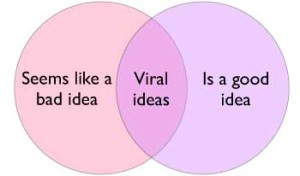
When I speak to audiences about Agile Marketing, it resonates. There is a hunger for a solution to what Rohn Jay Miller calls “the dysfunctional room that marketing lives in”.
I think there is no question that marketing has gone through more change in the last 3-5 years than at any time in the last 50 years. And many marketers are looking for something to help them cope with these changes.
Speed
Speed impacts marketing in myriad ways. Speed in the form of the speed of change: sites like Pinterest are virtually unknown one month, and three months later they’re a mandatory channel, driving more traffic than Twitter. Speed impacts marketing in the form of real-time events: the speed with which we need to react to news, negative or positive. Back in the nineties at the company I was with, we generally tried to react to any news within 48 hours. Today, that seems slow and anachronistic.
Speed also impacts marketing in terms of the speed with which we can get things done, which is both a blessing and a curse. For example, it used to be that if you wanted to put up a landing page, it might take IT several weeks to get one up. Now, with services like UnBounce and others, you can get a landing page up in hours, if not minutes. That’s great, but it also means that we’re doing the work, not IT, and we have no excuse for not doing things like A/B testing, which take time and expertise.
Agile Marketing addresses this need for speed in marketing, not because everyone runs full out in exhausting 3-4 week Sprints, but because it helps us focus on what’s important, removes barriers to getting things done, and puts the emphasis on results, not internal politics.
Fractured and Disrupted Channels of Communication

There are many more channels today through which it’s possible to communicate a marketing message. When I was growing up, there were three major television networks, and most marketing messages were communicated either by TV, radio, newspapers, magazines or perhaps billboards. All of those are still with us, but they have splintered into hundreds of television channels, millions of online sites, mobile devices, email, YouTube, Social Networks, location-based applications, etc. And not only are there are more channels, but the volume is louder, and therefore the audience has a much higher filter, tuning out or down most of our marketing messages. In a crowded, loud marketplace, we can’t just shout louder, we need to communicate differently, uniquely, so that we are heard.
Agile Marketing, with its focus on the customer and its focus on adaptive and iterative experiments, allows us to figure out which channels of communication and which messages work best for us, and helps us navigate our way through the fractured and disrupted maze of communication channels.
Limited Resources

Whenever I watch a Mad Men episode, I’m struck by how many people they have in the agency and how everyone but Peggy seems to have plenty of time to drink, carouse, gossip and generally do almost anything but work. Does anyone today work in that kind of environment? Not that I’ve seen.
We’re all having to do more with less: less budget, fewer people, less time. As marketers, we need to squeeze every dollar out of our budgets, every ounce of productivity out of our teams, and concrete results out of every hour. Agile Marketing helps us do that, again by focusing us on what’s important, and providing a method to iterate to concrete, measurable results. It also helps by encouraging collaboration over silos, and responding to change, rather than wasting time on plans that aren’t working.
What do you think? Does Agile Marketing resonate with you? And if so, why?
I’d really like to hear your thoughts.




I am a software engineer by training, but currently work in a B2C marketing team. Agile Marketing resonates with me because having been part of teams that followed a “traditional” process and an Agile process, Agile makes so much more sense.
The biggest difference I’ve seen between the two is that Agile processes are better at dealing with two always-present aspects of business: uncertainty and failure. In Agile, failure is seen as a good thing – since you’ve wasted at most a couple weeks, failing now means you won’t continue to work on a losing proposition. In a more traditional process, failure only comes at the end of a project (and therefore at a big loss!). With respect to uncertainty: in Agile, “I don’t know” is a perfectly good answer, because it’s understood that we will learn and refine our project and plan over time, and by the end of the project every important question will have an answer. In a traditional process, we “know” everything at the beginning, and since we make rigorous plans they are more likely to fall apart when one thing is out of place.
Another cool aspect of Agile is that what we saw about Agile Marketing applies equally to Agile Development, since neither is about Marketing or Development, it’s about how people interact and build teams.
I am a software engineer by training, but currently work in a B2C marketing team. Agile Marketing resonates with me because having been part of teams that followed a “traditional” process and an Agile process, Agile makes so much more sense.
The biggest difference I’ve seen between the two is that Agile processes are better at dealing with two always-present aspects of business: uncertainty and failure. In Agile, failure is seen as a good thing – since you’ve wasted at most a couple weeks, failing now means you won’t continue to work on a losing proposition. In a more traditional process, failure only comes at the end of a project (and therefore at a big loss!). With respect to uncertainty: in Agile, “I don’t know” is a perfectly good answer, because it’s understood that we will learn and refine our project and plan over time, and by the end of the project every important question will have an answer. In a traditional process, we “know” everything at the beginning, and since we make rigorous plans they are more likely to fall apart when one thing is out of place.
Another cool aspect of Agile is that what we saw about Agile Marketing applies equally to Agile Development, since neither is about Marketing or Development, it’s about how people interact and build teams.
James, that’s exactly right and super insightful. Any chance I can persuade you to guest blog sometime on my site?
James, that’s exactly right and super insightful. Any chance I can persuade you to guest blog sometime on my site?
Hi there – James – wow!
Jim – yesterday our ATL TAG Product Management Society hosted an event “The Agile Affect”. You guessed it, much discussion around how to integrate Agile-ity in other functional groups. Marketing was front and center.
Karol, glad to hear it. Were there any particular insights or questions that came up?
Sure, these come to mind:
– focus only on the important things, but from who’s perspective (ours/colleagues or company/customer)? could be a point of friction or a good way to start dialog. (Lot’s of head nods)
– Be aware that even in Agile development, there are delays due to “outside your control” such as obtaining licenses or legal reviews.
– MVP is possible outside of product development. Help your colleagues get their arms around how to do this too
Hi there – James – wow!
Jim – yesterday our ATL TAG Product Management Society hosted an event “The Agile Affect”. You guessed it, much discussion around how to integrate Agile-ity in other functional groups. Marketing was front and center.
Karol, glad to hear it. Were there any particular insights or questions that came up?
Sure, these come to mind:
– focus only on the important things, but from who’s perspective (ours/colleagues or company/customer)? could be a point of friction or a good way to start dialog. (Lot’s of head nods)
– Be aware that even in Agile development, there are delays due to “outside your control” such as obtaining licenses or legal reviews.
– MVP is possible outside of product development. Help your colleagues get their arms around how to do this too
Interesting. Good stuff.
Interesting. Good stuff.
Interesting post.
Key components of agile programming and agile innovation are continuous user input and market validation. Should they be included as central to agile marketing as well?
Gary,
Yes, I’d include user input and what I’d call validated learning. This particular article was more about the stressors on marketing that I believe cause Agile Marketing to resonate with people, but I’ve written elsewhere (https://agilemarketing.net/what-is-agile-marketing/) about what is included in Agile Marketing. You might also find Scott Brinker’s diagram on Agile Marketing interesting https://www.chiefmartec.com/2012/07/agile-marketing-in-a-single-whiteboard-sketch.html
Interesting post.
Key components of agile programming and agile innovation are continuous user input and market validation. Should they be included as central to agile marketing as well?
Gary,
Yes, I’d include user input and what I’d call validated learning. This particular article was more about the stressors on marketing that I believe cause Agile Marketing to resonate with people, but I’ve written elsewhere (https://agilemarketing.net/what-is-agile-marketing/) about what is included in Agile Marketing. You might also find Scott Brinker’s diagram on Agile Marketing interesting https://www.chiefmartec.com/2012/07/agile-marketing-in-a-single-whiteboard-sketch.html
I cannot agree more to the points you mention in your post Jim. I would also add (with my SEO agency perspective) that Agile Marketing is helping us better integrate with Dev teams within our clients offices, especially if they are using Agile methods already.
We can put one or more of our people directly into their existing teams and definitively work as a cross-functional team that can get the job done faster and easier.
Eric,
Thanks for your comments on the blog. Yeah, I agree, Agile Marketing does some wonderful things in terms of aligning marketing with Dev. You may have seen it already, but Jonathon Coleman has a wonderful SEOMoz Whiteboard Friday presentation on Agile Marketing, and he talks about the importance of building cross-functional teams.
Jim
I cannot agree more to the points you mention in your post Jim. I would also add (with my SEO agency perspective) that Agile Marketing is helping us better integrate with Dev teams within our clients offices, especially if they are using Agile methods already.
We can put one or more of our people directly into their existing teams and definitively work as a cross-functional team that can get the job done faster and easier.
Eric,
Thanks for your comments on the blog. Yeah, I agree, Agile Marketing does some wonderful things in terms of aligning marketing with Dev. You may have seen it already, but Jonathon Coleman has a wonderful SEOMoz Whiteboard Friday presentation on Agile Marketing, and he talks about the importance of building cross-functional teams.
Jim
Pingback: The Agile List - August 2012
Pingback: The Agile List - August 2012